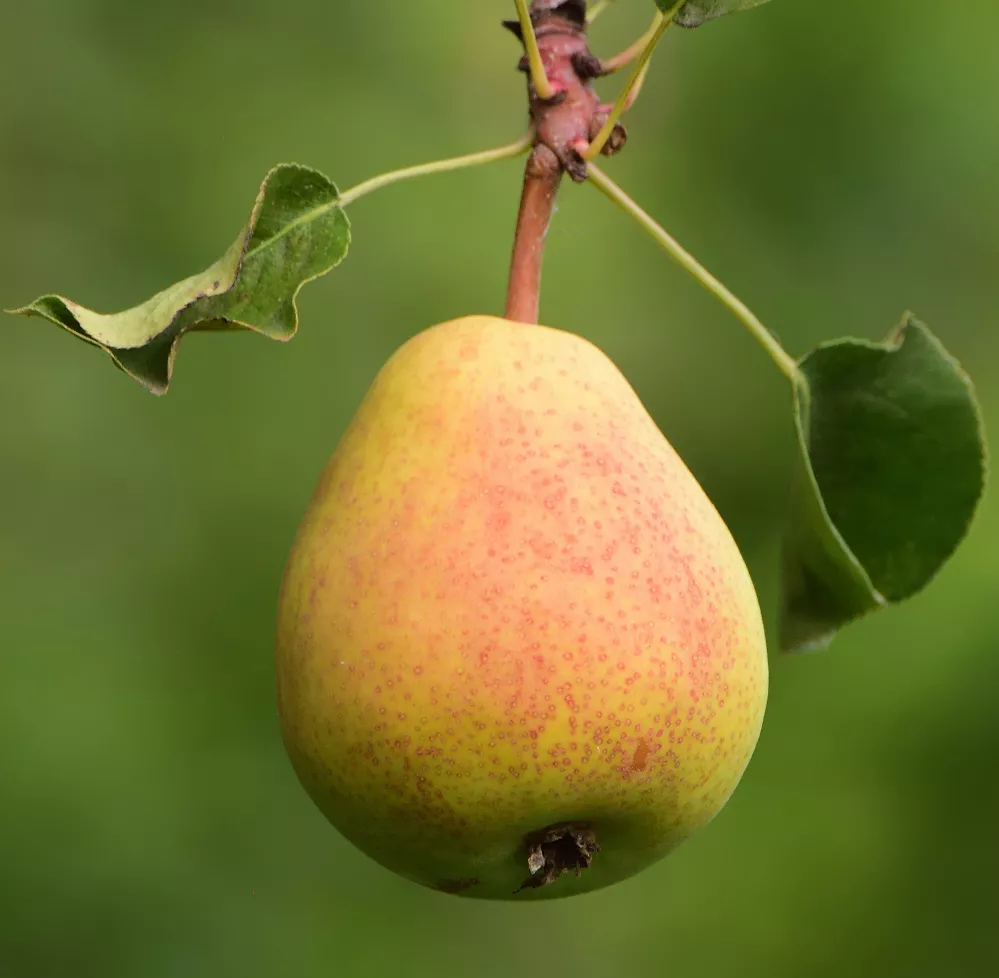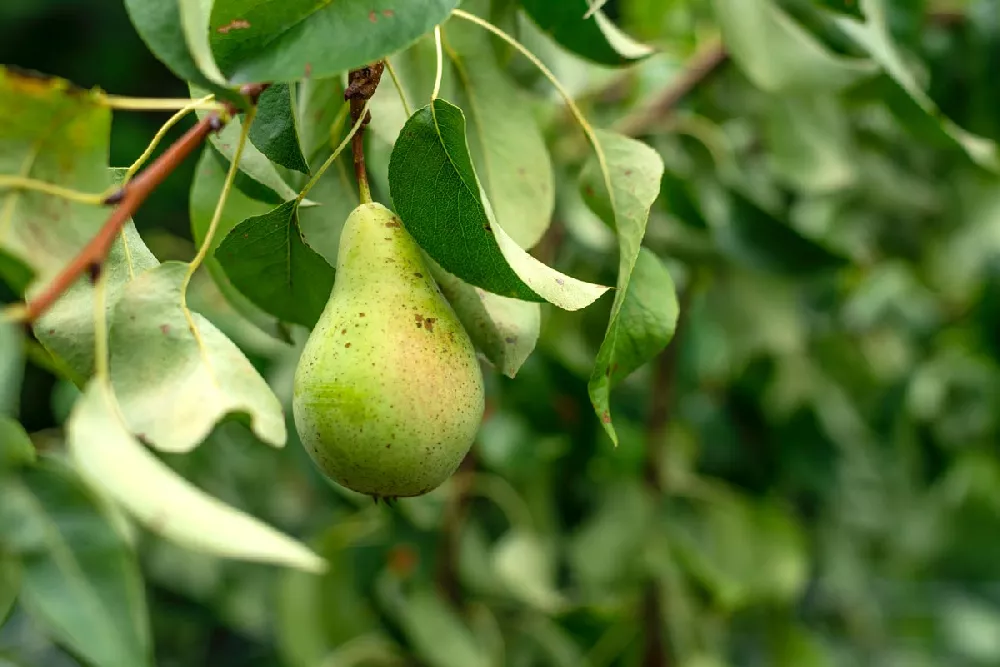- Home >
- Edible Plants >
- Shinseiki Asian Pear Tree
Shinseiki Asian Pear Tree for Sale - Buying & Growing Guide
If you're not familiar with Asian pears, we'd like to introduce the Shinseiki Asian pear tree, Pyrus pyrifolia 'Shinseiki.' This eye-catching tree stuns with profuse white blossoms in spring. But that's just the beginning. These are followed by a heavy crop of luscious, yellow-tan fruits in late summer. Asian pears are crisp and juicy, with fine grained flesh that has none of the granularity you find in European pears. The fruits are excellent for fresh eating and also excel when used in cooking. They are a great choice for a dessert pear. In fall, the tree is covered with bright red leaves, and in winter, the attractive silhouette makes this a truly four-season plant. Here are a few other reasons to love the Shinseiki Asian pear tree:
- These pear trees grow only to a maximum of 8 to 10 feet, making for easy harvests.
- Shinseiki Asian pear trees are tolerant of both heat and cold and able to handle temperatures down to -10 degrees Fahrenheit.
- Their fruit can be stored in a cool basement or garage for up to five months.
Enter your zip code to find nearby stores that may carry this plant.
Plant Care
Sunlight

Site your tree in partial to full sun — at least four hours of direct light a day.
Watering
Your Shinseiki Asian pear tree needs roughly 1 to 2 inches of water a week, either from rain or supplemental watering.
Fertilizing

Fertilize in spring with a balanced product designed for fruiting trees.
Planting and Care
Planting instructions
Although the Shinseiki Asian pear tree will tolerate partial shade, it does best when it receives more than four hours of direct light a day, so site it where it will get maximum sun. Unpot your sapling and tease out any encircling roots, which can girdle the tree and slowly kill it. Dig a hole that’s as deep as the root ball and two to three times as wide. Place the tree in the hole, and, while holding it upright and steady, fill in around it with good-quality topsoil, tamping down as you go to eliminate air pockets. Make sure that the graft union, which appears as a slight bump on the trunk near the roots, is not covered. Water thoroughly. Apply a 2- to 3-inch layer of an organic mulch, such as bark chips, around the tree’s root zone to conserve moisture and hinder weeds.
Watering and nutrients
For the tree’s first year, water every few days unless you receive rainfall. Once the tree is showing signs of robust new growth, you can taper back. A mature tree needs 1 to 2 inches of water a week. Hold off on watering once frost season approaches. Fertilize your tree as per package directions with a balanced, slow-release product that’s designed for fruit trees.
Pollination
Asian pears are primarily pollinated by honeybees and other insects. The trees are self-fertile, which means a single tree has both male and female reproductive parts. You may be able to increase your harvest, though, by planting more than one Shinseiki Asian pear tree, placing them about 15 feet apart from each other.
Pruning
Shinseiki Asian pear trees do need pruning annually. First, monitor your tree for broken, diseased, or damaged limbs, and trim these out whenever you see them. When removing a branch, cut it back to the branch collar, which is the swelling where it joins another branch, but do not cut into the collar. In early spring before bud break, trim the tree back to a central leader (main branch), with five or six strong horizontal branches spaced around the tree. Cut them back by a third. When the tree has matured, thin out the canopy each spring to allow light and air to circulate.
Pests, diseases, and animals
Watch your trees for signs of insect infestation from pests such as aphids, caterpillars, and pear midge. Keeping the ground around your tree clear of debris will make it less likely to be bothered by insects, since they have fewer places to hide. Common diseases of Asian pear trees include fire blight, pear rust, and blossom wilt. Fire blight is the most common — it causes branches, flowers, and fruit to blacken and die off. Trim back any branches that show signs of it, cutting to healthy wood. Applications of liquid copper may be an effective treatment.
Harvesting
Unlike European pears, Asian pears ripen on the tree and do not need to be stored to attain their full flavor. They are ready to harvest when they are easily pulled off the tree. A good way of knowing they are ripe is to do a simple taste test. They are best harvested by hand, and they should be stored in a cool place after harvest.
Achieving maximum results
If you’re new to growing fruit trees, you may be put off by tales of weekly spraying and multiple diseases. But it doesn’t have to be that way, and growing an Asian pear tree is no more difficult than growing, say, a lilac bush. Having said that, there are a few things you can do to ensure a successful harvest. First, once your tree has set fruit, prune out some of the smaller pears so that you’re left with only the largest and best quality fruit. Second, pruning doesn’t need to be a mysterious task. If you remember just to let the tree grow a strong central leader and trim back other branches as needed, you’ll be fine. Third, be vigilant in watching for fire blight, which can hinder your tree’s harvest and, in worst case scenarios, kill the tree. Fortunately, the Shinseiki Asian pear tree is moderately resistant to fire blight, so you will probably never see signs of it.
FAQs
Where will my Shinseiki Asian pear tree grow?
These Asian pears are hardy in USDA hardiness zones 5 through 9, which encompasses most of the continental U.S. It can handle temperatures as low as -10 degrees Fahrenheit, and that means it can even be grown in all but the most northern parts of New England and all the way to southern Texas. The Pacific Northwest is one area that is particularly known for growing Asian pears, so if you live along the upper West Coast, it's worth planting one or more in your garden.
Do I need another pear tree to pollinate my Asian pear tree?
As we noted above, the Shinseiki Asian pear tree is self-fertile, though you'll have a larger harvest if you plant more than one. The good news is that you can plant several different types of pear tree and still have the benefits of cross-pollination. This Asian pear tree will pollinate with European pear trees as long as they flower at the same time.
What's the best use of a Shinseiki Asian pear tree in the garden?
The Shinseiki Asian pear tree makes an excellent specimen tree for the front or back yard. Consider planting an odd number cluster in a sunny spot in front of your home. It will be spectacular during bloom time. This pear is also a great choice for the informal or cottage garden. It can even be trained to grow up against a trellis or wall, a practice that is known as espaliering.
Compare Similar Products
Customer Reviews
 Shinseiki Asian Pear
Shinseiki Asian PearI think it's going well.
You can't add more Product Name - Product size to the cart.
OK








